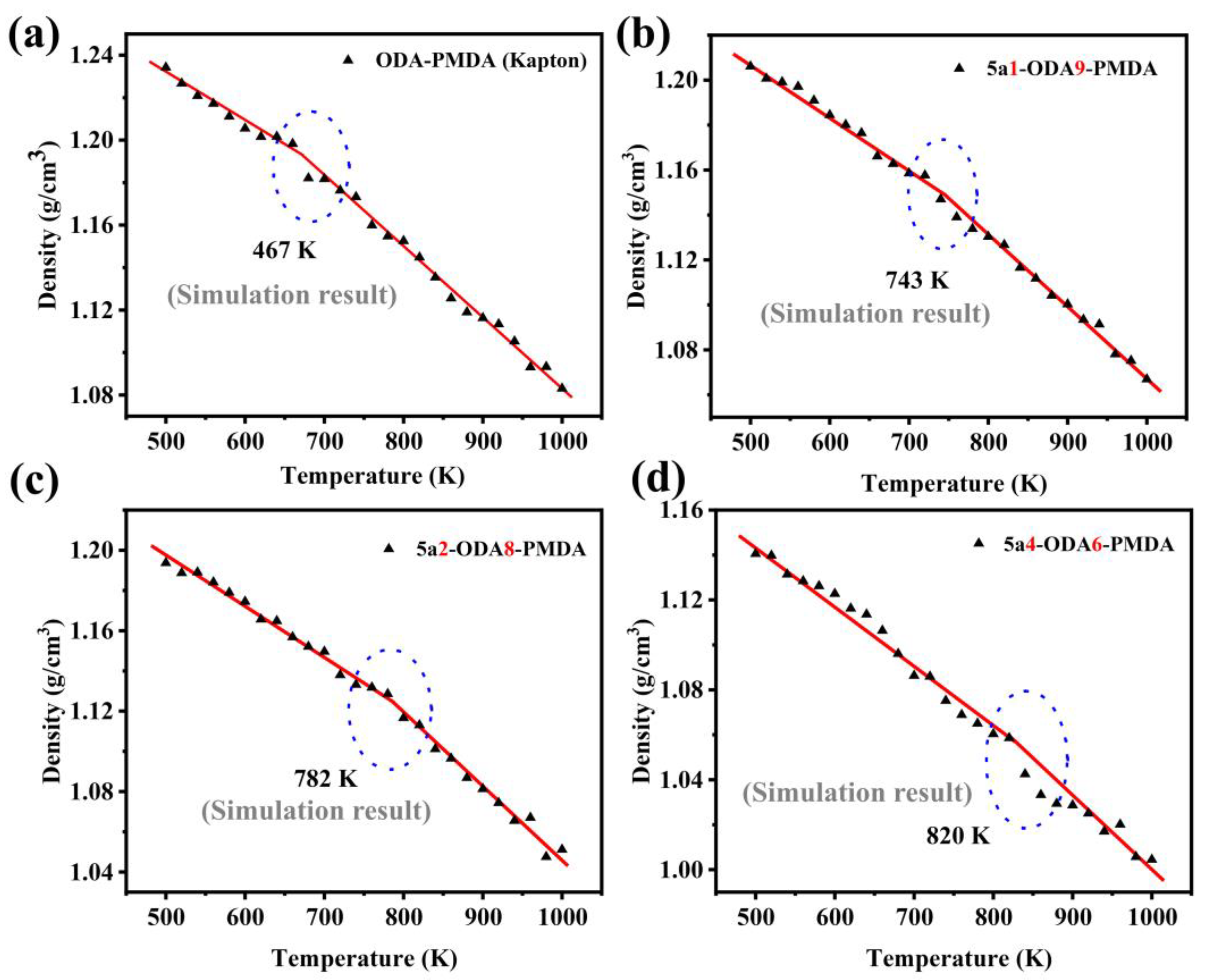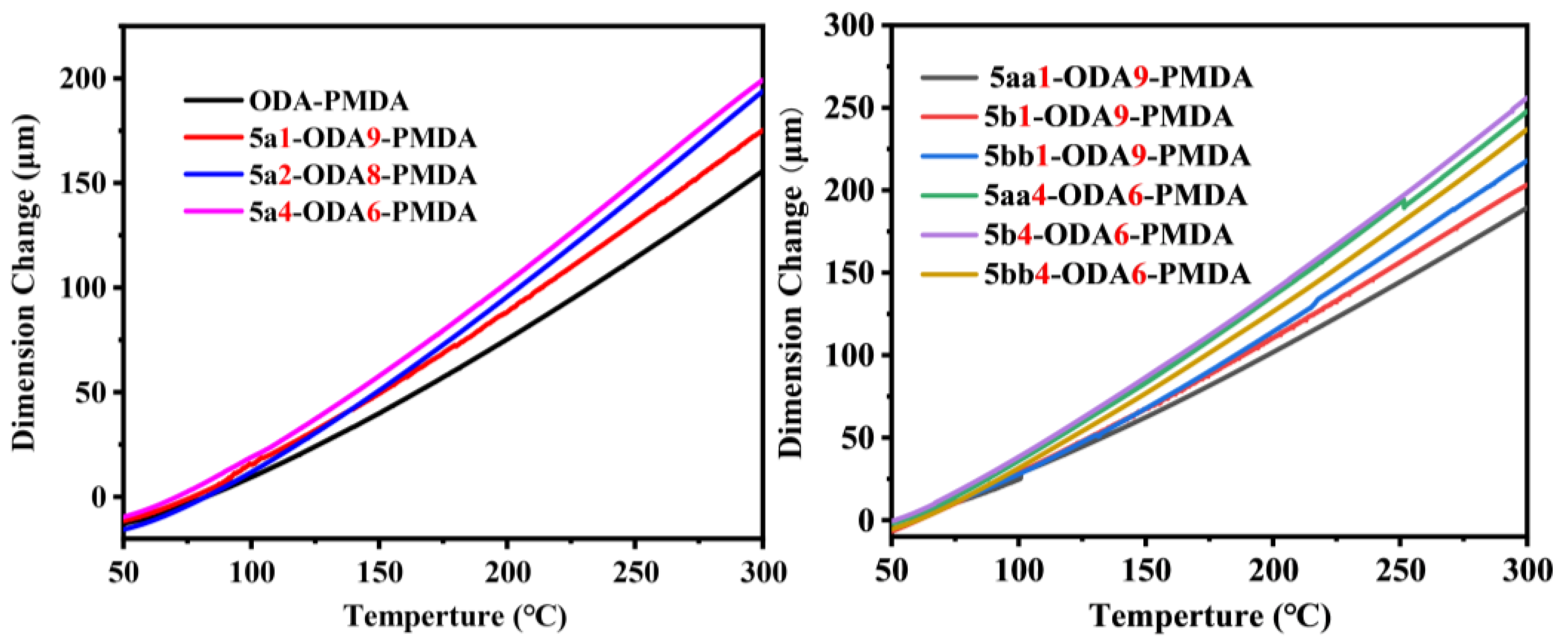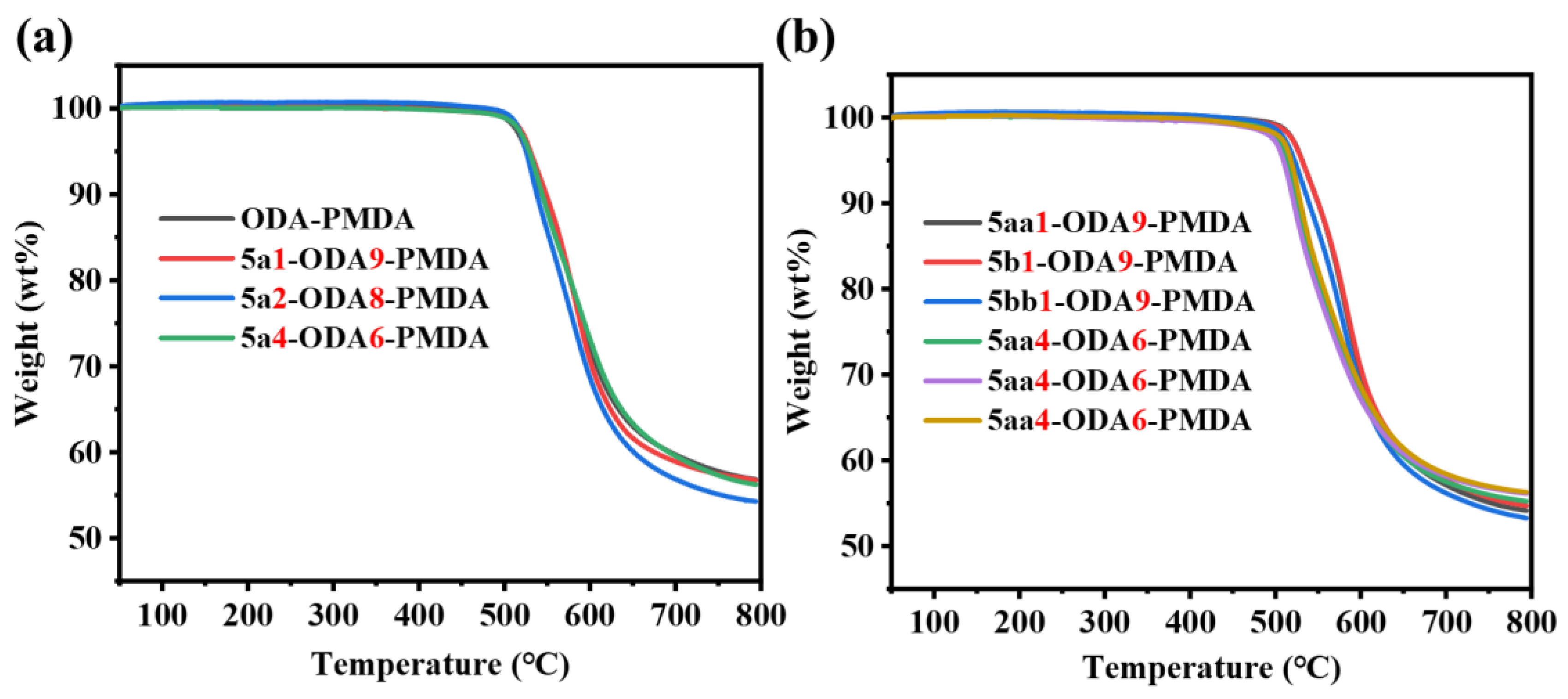Exceptionally High-Temperature-Resistant Kapton-Type Polyimides with Tg > 520 °C: Synthesis via Incorporation of Spirobis(indene)-bis(benzoxazole)-Containing Diamines
Abstract
:1. Introduction
2. Experimental Section
2.1. Materials and Characterization
2.2. Monomer Synthesis
2.3. Preparation of Polyimide Films
3. Results and Discussion
3.1. Characterization of Polyimides
3.2. XRD Analysis
3.3. Thermal Properties
3.4. Mechanical Properties
3.5. Dielectric Properties
4. Conclusions
Supplementary Materials
Author Contributions
Funding
Institutional Review Board Statement
Data Availability Statement
Conflicts of Interest
References
- Gouzman, I.; Grossman, E.; Verker, R.; Atar, N.; Bolker, A.; Eliaz, N. Advances in polyimide-based materials for space applications. Adv. Mater. 2019, 31, 1807738. [Google Scholar]
- Pan, X.F.; Wu, B.; Gao, H.-L.; Chen, S.M.; Zhu, Y.; Zhou, L.; Wu, H.; Yu, S.H. Double-layer nacre-inspired polyimide-mica nanocomposite films with excellent mechanical stability for LEO environmental conditions. Adv. Mater. 2022, 34, 2105299. [Google Scholar] [CrossRef] [PubMed]
- Shi, S.; Yao, L.; Ma, P.; Jiao, Y.; Zheng, X.; Ning, D.; Chen, M.; Sui, F.; Liu, H.; Yang, C.; et al. Recent progress in the high-temperature-resistant PI substrate with low CTE for CIGS thin-film solar cells. Mater. Today Energy 2021, 20, 100640. [Google Scholar] [CrossRef]
- Subudhi, P.; Punetha, D. Progress, challenges, and perspectives on polymer substrates for emerging flexible solar cells: A holistic panoramic review. Prog. Photovolt. 2023, 31, 753. [Google Scholar]
- Dong, H.; Wang, Y.P.; Li, X.T.; Zhao, X.; Dong, J.; Zhang, Q.H. Dry-spun polyimide fibers with excellent thermal stability, intrinsic flame retardancy and ultralow smoke release. Chin. J. Polym. Sci. 2022, 40, 1422. [Google Scholar]
- Fang, Y.; He, X.; Kang, J.C.; Wang, L.; Ding, T.M.; Lu, X.; Zhang, S.Y.; Lu, Q. Terphenyl-based colorless and heat-resistant polyimides with a controlled molecular structure using methyl side groups. Polym. Chem. 2022, 13, 5105. [Google Scholar]
- Yu, Q.X.; Bei, R.X.; Liu, J.H.; He, Y.W.; Liu, S.W.; Chi, Z.G.; Xu, J.R.; Zhang, Y. Bioinspired polyimide film with fire retardant and gas barrier properties by gravity-induced deposition of montmorillonite. Aggregate 2023, 4, e392. [Google Scholar]
- Yang, C.; Xie, D.; Li, S.; Song, L.; Yuan, Z. Electrospun fine-diameter polyimide nanofiber membranes via metal wire-based needle-free technique for high-efficiency PM0.3 filtration at high-temperature. Sep. Purif. Technol. 2025, 357, 130115. [Google Scholar]
- Xie, F.; Wang, Y.; Zhuo, L.; Jia, F.; Ning, D.; Lu, Z. Electrospun wrinkled porous polyimide nanofiber-based filter via thermally induced phase separation for efficient high-temperature PMs capture. ACS Appl. Mater. Interfaces 2020, 12, 56499. [Google Scholar]
- Han, S.; Ren, X.; Li, D.; Song, Z.; Yang, C.; Wang, Z.; Liu, J. Preparation and characterizations of intrinsically black polyesterimide films with good thermal Endurance at elevated temperatures for potential two-layer flexible copper clad laminate applications. Polymers 2025, 17, 304. [Google Scholar] [CrossRef]
- Gu, H.; Liu, C.; Liu, Q.; Jia, H.; Qiao, Y.; Zhao, W.; Chen, Y.; Jian, X. High- and low-temperature resistant and intrinsically flame retardant poly(bisphthalazinone thioether sulfone ketone)s: Synthesis, structures and properties. Chem. Eng. J. 2023, 471, 144480. [Google Scholar] [CrossRef]
- Gu, C.; Li, J.; Zhao, Y.; Zhang, C.; Fan, Q.; Liu, Q.; Zhang, S.; Zhang, Y.; Jian, X.; Weng, Z. Enhanced high-temperature capacitive performance through introduction of polar groups in poly(aryl ether ketone) dielectric polymer. J. Energy Storage 2024, 95, 112570. [Google Scholar] [CrossRef]
- Doyle, L.; Pérez-Ferrero, X.; García-Molleja, J.; Losada, R.; Romero-Rodríguez, P.; Fernández-Blázquez, J.P. Fused filament fabrication of slow-crystallizing polyaryletherketones: Crystallinity and mechanical properties linked to processing and post-treatment parameters. Polymers 2024, 16, 3354. [Google Scholar] [CrossRef] [PubMed]
- Tang, H.; Geng, K.; Hu, Y.; Li, N. Synthesis and properties of phosphonated polysulfones for durable high-temperature proton exchange membranes fuel cell. J. Membr. Sci. 2020, 605, 118107. [Google Scholar]
- Wu, Z.; Su, Q.; Yang, J.; Wei, Z.; Zhang, G. Promotion of thermochromic luminous polysulfone membrane towards smart high-temperature PM2.5 filtration and fire alarming. Sep. Purif. Technol. 2024, 328, 125047. [Google Scholar]
- Sugihara, O.; Tomiki, M.; Fujimura, H.; Egami, C.; Okamoto, N.; Akizuki, T.; Shirai, H. Heat-resistant polyarylates for waveguide-type device application. Jpn. J. Appl. Phys. 2000, 39, L1174. [Google Scholar]
- Yu, Z.; Wu, S.; Li, C.; Xiao, Y.; Zheng, L.; Liu, J.; Zhang, B. Ultra-low dielectric constant fluorinated graphene/polybenzoxazole composite films with excellent thermal stabilities and mechanical properties. Compos. Part A Appl. Sci. Manuf. 2021, 145, 106387. [Google Scholar]
- Gao, Y.; Wu, S.; Li, C.; Xiao, Y.; Liu, J.; Zhang, B. Hydrogen-bond- and shear-field-Induced self-Assembly for the efficient preparation of polybenzoxazole nanofibers with excellent mechanical properties and heat resistance. Macromolecules 2022, 55, 9420. [Google Scholar] [CrossRef]
- Zhang, Y.; Chen, Y.; Wang, M.; Su, W.; Li, H.; Li, P.; Zhang, X. Preparation of high temperature resistant polyamide composite nanofiltration membranes by thermally assisted interfacial polymerization. J. Membr. Sci. 2023, 687, 122020. [Google Scholar]
- Xia, H.; Jiang, Z.; Tang, J.; Tang, J.; Zhou, J.; Yang, Z.; Zheng, R.; Niu, J. Preparation and properties of PA10T/PPO blends compatibilized with SEBS-g-MAH. Polymers 2024, 16, 1598. [Google Scholar] [CrossRef]
- Lyu, X.; Xiao, A.; Shi, D.; Li, Y.; Shen, Z.; Chen, E.-Q.; Zheng, S.; Fan, X.-H.; Zhou, Q.-F. Liquid crystalline polymers: Discovery, development, and the future. Polymer 2020, 202, 122740. [Google Scholar]
- Wei, W.; Xiong, H. Liquid-crystalline polymers: Molecular engineering, hierarchical structures, and applications. Langmuir 2022, 38, 11514. [Google Scholar]
- Lian, M.; Lu, X.; Lu, Q. Synthesis of superheat-resistant polyimides with high Tg and low coefficient of thermal expansion by introduction of strong intermolecular interaction. Macromolecules 2018, 51, 10127. [Google Scholar]
- Xiao, P.; He, X.; Ye, C.; Zhang, S.; Zheng, F.; Lu, Q.; Ma, X. Tailoring the microporosity and gas separation property of soluble polybenzoxazole membranes derived from different regioisomer monomers. Sep. Purif. Technol. 2023, 311, 123340. [Google Scholar]
- Liu, Z.; Zhang, S.; Yuan, J.; Lu, Q. New developments in intrinsic black photosensitive polyimide for advanced display applications. Mater. Today Chem. 2024, 42, 102346. [Google Scholar]
- He, X.; Zhang, S.; Zhang, C.; Xiao, P.; Zheng, F.; Lu, Q. Decoding high-frequency dielectric loss of Poly(ester imide)s: Molecular simulation and experiment validation. Polymer 2024, 308, 127337. [Google Scholar]
- Zhang, S.; He, X.; Xiao, P.; Xia, X.; Zheng, F.; Xiang, S.; Lu, Q. Interpretable machine learning for investigating the molecular mechanisms governing the transparency of colorless transparent polyimide for OLED cover windows. Adv. Funct. Mater. 2024, 34, 2409143. [Google Scholar]
- Dong, H.; Dong, J.; Li, X.; Zhao, X.; Xu, Q.; Zhang, J.; Zhang, Q. Preparation of high-temperature resistant polyimide fibers by introducing the p-phenylenediamine into Kapton-type polyimide. ACS Appl. Polym. Mater. 2024, 6, 2371. [Google Scholar]
- Sibin, K.P.; Mary Esther, A.C.; Shashikala, H.D.; Dey, A.; Sridhara, N.; Sharma, A.K.; Barshilia, H.C. Environmental stability of transparent and conducting ITO thin films coated on flexible FEP and Kapton® substrates for spacecraft applications. Sol. Energy Mater. Sol. Cells 2018, 176, 134. [Google Scholar]
- Ren, W.; Yang, M.; Guo, M.; Zhou, L.; Pan, J.; Xiao, Y.; Xu, E.; Nan, C.-W.; Shen, Y. Metallized stacked polymer film capacitors for high-temperature capacitive energy storage. Energy Storage Mater. 2024, 65, 103095. [Google Scholar]
- Jeong, S.; Ham, S.S.; Choi, E.P.; Hwang, D.J.; Yu, H.; Kim, W.M.; Kim, G.Y.; Jeong, J.-H. Enhanced mechanical stability of CIGS solar module with glass/polyimide/indium tin oxide for potentially flexible applications. ACS Appl. Energy Mater. 2023, 6, 3745. [Google Scholar] [CrossRef]
- Hasegawa, M.; Kaneki, T.; Tsukui, M.; Okubo, N.; Ishii, J. High-temperature polymers overcoming the trade-off between excellent thermoplasticity and low thermal expansion properties. Polymer 2016, 99, 292. [Google Scholar] [CrossRef]
- Liu, T.Q.; Zheng, F.; Ma, X.; Ding, T.-M.; Chen, S.; Jiang, W.; Zhang, S.Y.; Lu, Q. High heat-resistant polyimide films containing quinoxaline moiety for flexible substrate applications. Polymer 2020, 209, 122963. [Google Scholar] [CrossRef]
- Yang, Z.; Ma, P.; Li, F.; Guo, H.; Kang, C.; Gao, L. Ultrahigh thermal-stability polyimides with low CTE and required flexibility by formation of hydrogen bonds between poly(amic acid)s. Eur. Polym. J. 2021, 148, 110369. [Google Scholar] [CrossRef]
- Liu, Y.; Huang, J.; Tan, J.; Zeng, Y.; Liu, J.; Zhang, H.; Pei, Y.; Xiang, X.; Liu, Y. Intrinsic high-barrier polyimide with low free volume derived from a novel diamine monomer containing rigid planar moiety. Polymer 2017, 114, 289. [Google Scholar] [CrossRef]
- Xiao, P.; He, X.; Zheng, F.; Lu, Q. Super-heat resistant, transparent and low dielectric polyimides based on spirocyclic bisbenzoxazole diamines with Tg > 450 °C. Polym. Chem. 2022, 13, 3660. [Google Scholar] [CrossRef]
- Matsumoto, T.; Ozawa, H.; Ishiguro, E.; Komatsu, S. Properties of alicyclic polyimides with bis-spironorbornane structure prepared in various solvents. J. Photopolym. Sci. Technol. 2016, 29, 237. [Google Scholar] [CrossRef]
- Liu, Y.; Zhou, Z.; Qu, L.; Zou, B.; Chen, Z.; Zhang, Y.; Liu, S.; Chi, Z.; Chen, X.; Xu, J. Exceptionally thermostable and soluble aromatic polyimides with special characteristics: Intrinsic ultralow dielectric constant, static random access memory behaviors, transparency and fluorescence. Mater. Chem. Front. 2017, 1, 326. [Google Scholar] [CrossRef]
- Wang, C.; Chen, W.; Chen, Y.; Zhao, X.; Li, J.; Ren, Q. Synthesis and properties of new fluorene-based polyimides containing trifluoromethyl and isopropyl substituents. Mater. Chem. Phys. 2014, 144, 553. [Google Scholar] [CrossRef]
- Miao, J.; Hu, X.; Wang, X.; Meng, X.; Wang, Z.; Yan, J. Colorless polyimides derived from adamantane-containing diamines. Polym. Chem. 2020, 11, 6009. [Google Scholar] [CrossRef]
- Wu, Y.; Chen, G.; Feng, C.; Yang, J. High Tg and thermo-oxidatively stable thermosetting polyimides derived from a carborane-containing diamine. Macromol. Rapid Commun. 2018, 39, 1800484. [Google Scholar]
- Hu, J.; Li, R.; Chen, C.; Lu, Z.; Zeng, K.; Yang, G. New insights into mechanism of negative in-plane CTE based on bio-based adenine-containing polyimide film. Polymer 2018, 146, 133. [Google Scholar] [CrossRef]
- Wu, Z.; He, J.; Yang, H.; Yang, S. Progress in aromatic polyimide films for electronic applications: Preparation, structure and properties. Polymers 2022, 14, 1269. [Google Scholar] [CrossRef] [PubMed]
- Ma, X.; Zheng, F.; van Sittert, C.G.C.E.; Lu, Q. Role of intrinsic factors of polyimides in glass transition temperature: An atomistic investigation. J. Phys. Chem. B 2019, 123, 8569. [Google Scholar]
- Qiu, H.; Wang, J.; Qiu, X.; Dai, X.; Sun, Z.-Y. Heat-resistant polymer discovery by utilizing interpretable graph neural network with small data. Macromolecules 2024, 57, 3515. [Google Scholar]
- Patrone, P.N.; Dienstfrey, A.; Browning, A.R.; Tucker, S.; Christensen, S. Uncertainty quantification in molecular dynamics studies of the glass transition temperature. Polymer 2016, 87, 246. [Google Scholar] [CrossRef]
- Mohammadi, M.; Fazli, H.; Karevan, M.; Davoodi, J. The glass transition temperature of PMMA: A molecular dynamics study and comparison of various determination methods. Eur. Polym. J. 2017, 91, 121. [Google Scholar]
- Han, J.; Gee, R.H.; Boyd, R.H. Glass transition temperatures of polymers from molecular dynamics simulations. Macromolecules 1994, 27, 7781. [Google Scholar]
- Ree, M.; Kim, K.; Woo, S.H.; Chang, H. Structure, chain orientation, and properties in thin films of aromatic polyimides with various chain rigidities. J. Appl. Phys. 1997, 81, 698. [Google Scholar]
- Xiao, P.; He, X.; Zheng, F.; Lu, Q. Soluble polyimides with ultralow dielectric constant and dielectric loss and high colorless transparency based on spirobisindane-bis (aryl ester) diamines. Eur. Polym. J. 2024, 221, 113580. [Google Scholar] [CrossRef]
- Prateek; Thakur, V.K.; Gupta, R.K. Recent progress on ferroelectric polymer-based nanocomposites for high energy density capacitors: Synthesis, dielectric properties, and future aspects. Chem. Rev. 2016, 116, 4260. [Google Scholar] [PubMed]
- Zhu, L. Exploring strategies for high dielectric constant and low loss polymer dielectrics. J. Phys. Chem. Lett. 2014, 5, 3677. [Google Scholar] [CrossRef] [PubMed]
- Sawada, R.; Ando, S. Polarization analysis and humidity dependence of dielectric properties of aromatic and semialicyclic polyimides measured at 10 GHz. J. Phys. Chem. C 2024, 128, 6979. [Google Scholar]
- Hofman, D.; Ulbrich, J.; Fritsch, D.; Paul, D. Molecular modelling simulation of gas transport in amorphous polyimide and poly(amide imide) membrane materials. Polymer 1996, 37, 4773. [Google Scholar]
- Abe, A.; Jernigan, R.L.; Flory, P.J. Conformational Energies of n-Alkanes and the Random Configuration of Higher Homologs Including Polymethylene. J. Am. Chem. Soc. 1966, 88, 631. [Google Scholar]
- Evans, D.J.; Holian, B.L. The Nose–Hoover thermostat. J. Chem. Phys. 1985, 83, 4069. [Google Scholar]
- Faller, R.; de Pablo, J.J. Constant pressure hybrid Molecular Dynamics–Monte Carlo simulations. J. Chem. Phys. 2002, 116, 55. [Google Scholar]
- Liu, H.Y.; Fang, C.H.; Fang, Y.; Zhou, Y.Q.; Ge, H.W.; Zhu, F.Y.; Sun, P.C.; Miao, J.T. Characterizing Ni(II) hydration in aqueous solution using DFT and EXAFS. J. Mol. Model. 2015, 22, 2. [Google Scholar]
- Shi, W.-Y.; Ding, C.; Yan, J.-L.; Han, X.-Y.; Lv, Z.-M.; Lei, W.; Xia, M.-Z.; Wang, F.-Y. Molecular dynamics simulation for interaction of PESA and acrylic copolymers with calcite crystal surfaces. Desalination 2012, 291, 8. [Google Scholar]
- Fox, T.G., Jr.; Flory, P.J. Second-Order Transition Temperatures and Related Properties of Polystyrene. I. Influence of Molecular Weight. J. Appl. Phys. 1950, 21, 581. [Google Scholar]
- Fox, T.G., Jr.; Flory, P.J. Further Studies on the Melt Viscosity of Polyisobutylene. J. Phys. Chem. 1951, 55, 221. [Google Scholar] [CrossRef] [PubMed]
- Fox, T.G.; Flory, P.J. The glass temperature and related properties of polystyrene. Influence of molecular weight. J. Polym. Sci. 1954, 14, 315. [Google Scholar] [CrossRef]







| PAAs | Mn (×104) a | Mw (×104) a | PDI b | ρ (g m−3) | Thickness (μm) |
|---|---|---|---|---|---|
| ODA-PMDA (Kapton) | 6.4 | 11.4 | 1.8 | 1.402 | 34 |
| 5a1-ODA9-PMDA | 8.9 | 17.5 | 2.0 | 1.391 | 32 |
| 5a2-ODA8-PMDA | 9.4 | 19.1 | 2.0 | 1.375 | 36 |
| 5a4-ODA6-PMDA | 9.7 | 20.2 | 2.1 | 1.358 | 32 |
| 5a5-ODA5-PMDA | 8.8 | 20.5 | 2.3 | - | Brittle |
| 5aa1-ODA9-PMDA | 7.7 | 15.3 | 1.9 | 1.395 | 31 |
| 5b1-ODA9-PMDA | 7.3 | 14.6 | 2.0 | 1.393 | 45 |
| 5bb1-ODA9-PMDA | 5.9 | 11.2 | 1.9 | 1.389 | 31 |
| 5aa4-ODA6-PMDA | 5.3 | 12.3 | 2.3 | 1.359 | 36 |
| 5b4-ODA6-PMDA | 7.2 | 15.8 | 2.2 | 1.361 | 31 |
| 5bb4-ODA6-PMDA | 6.1 | 12.7 | 2.1 | 1.357 | 39 |
| Polyimide | Tg (°C) a | Td5% (°C) b | Td10% (°C) c | Rw (%) d | CTE (ppm/K) e |
|---|---|---|---|---|---|
| ODA-PMDA | 396 | 558 | 581 | 56.8 | 32 |
| 5a1-ODA9-PMDA | 467 | 530 | 549 | 56.7 | 34 |
| 5a2-ODA8-PMDA | 500 | 525 | 539 | 54.3 | 36 |
| 5a4-ODA6-PMDA | >520 | 522 | 535 | 56.2 | 38 |
| 5aa1-ODA9-PMDA | 454 | 532 | 551 | 54.1 | 34 |
| 5b1-ODA9-PMDA | 463 | 533 | 554 | 54.7 | 36 |
| 5bb1-ODA9-PMDA | 444 | 523 | 540 | 53.2 | 39 |
| 5aa4-ODA6-PMDA | >510 | 515 | 526 | 55.2 | 43 |
| 5b4-ODA6-PMDA | 509 | 512 | 523 | 56.1 | 45 |
| 5bb4-ODA6-PMDA | 504 | 518 | 530 | 56.3 | 42 |
| Polyimide | σ (MPa) a | E (GPa) b | ε (%) c |
|---|---|---|---|
| ODA-PMDA | 127.3 ± 5.3 | 1.6 ± 0.3 | 33.1 ± 3.8 |
| 5a1-ODA9-PMDA | 132.6 ± 6.3 | 2.5 ± 0.4 | 16.6 ± 1.2 |
| 5a2-ODA8-PMDA | 118.3 ± 9.3 | 3.3 ± 0.3 | 5.8 ± 1.5 |
| 5a4-ODA6-PMDA | 97.5 ± 7.4 | 4.7 ± 0.5 | 2.9 ± 0.9 |
| 5aa1-ODA9-PMDA | 133.8 ± 6.2 | 2.4 ± 0.4 | 16.5 ± 1.9 |
| 5b1-ODA9-PMDA | 131.6 ± 10.2 | 2.6 ± 0.5 | 15.8 ± 2.1 |
| 5bb1-ODA9-PMDA | 125.3 ± 7.9 | 3.5 ± 0.6 | 14.7 ± 1.7 |
| 5aa4-ODA6-PMDA | 105.2 ± 6.9 | 4.1 ± 0.3 | 3.3 ± 0.5 |
| 5b4-ODA6-PMDA | 101.3 ± 7.8 | 3.4 ± 0.4 | 4.4 ± 0.6 |
| 5bb4-ODA6-PMDA | 98.3 ± 8.4 | 4.7 ± 0.4 | 2.8 ± 0.5 |
| Polyimide | Dk a | A (%) b | ||
|---|---|---|---|---|
| 10 GHz | 40 GHz | 60 GHz | ||
| ODA-PMDA | 3.51 | 3.48 | 3.50 | 2.62 |
| 5a1-ODA9-PMDA | 3.37 | 3.35 | 3.31 | 2.44 |
| 5a2-ODA8-PMDA | 3.16 | 3.15 | 3.13 | 2.28 |
| 5a4-ODA6-PMDA | 3.08 | 2.89 | 2.87 | 1.93 |
| 5aa1-ODA9-PMDA | 3.34 | 3.35 | 3.34 | 2.48 |
| 5b1-ODA9-PMDA | 3.38 | 3.38 | 3.37 | 2.45 |
| 5bb1-ODA9-PMDA | 3.34 | 3.33 | 3.33 | 2.47 |
| 5aa4-ODA6-PMDA | 3.06 | 2.95 | 2.92 | 1.95 |
| 5b4-ODA6-PMDA | 3.02 | 2.88 | 2.87 | 1.98 |
| 5bb4-ODA6-PMDA | 2.98 | 2.89 | 2.96 | 1.96 |
Disclaimer/Publisher’s Note: The statements, opinions and data contained in all publications are solely those of the individual author(s) and contributor(s) and not of MDPI and/or the editor(s). MDPI and/or the editor(s) disclaim responsibility for any injury to people or property resulting from any ideas, methods, instructions or products referred to in the content. |
© 2025 by the authors. Licensee MDPI, Basel, Switzerland. This article is an open access article distributed under the terms and conditions of the Creative Commons Attribution (CC BY) license (https://creativecommons.org/licenses/by/4.0/).
Share and Cite
Xiao, P.; He, X.; Lu, Q. Exceptionally High-Temperature-Resistant Kapton-Type Polyimides with Tg > 520 °C: Synthesis via Incorporation of Spirobis(indene)-bis(benzoxazole)-Containing Diamines. Polymers 2025, 17, 832. https://doi.org/10.3390/polym17070832
Xiao P, He X, Lu Q. Exceptionally High-Temperature-Resistant Kapton-Type Polyimides with Tg > 520 °C: Synthesis via Incorporation of Spirobis(indene)-bis(benzoxazole)-Containing Diamines. Polymers. 2025; 17(7):832. https://doi.org/10.3390/polym17070832
Chicago/Turabian StyleXiao, Peng, Xiaojie He, and Qinghua Lu. 2025. "Exceptionally High-Temperature-Resistant Kapton-Type Polyimides with Tg > 520 °C: Synthesis via Incorporation of Spirobis(indene)-bis(benzoxazole)-Containing Diamines" Polymers 17, no. 7: 832. https://doi.org/10.3390/polym17070832
APA StyleXiao, P., He, X., & Lu, Q. (2025). Exceptionally High-Temperature-Resistant Kapton-Type Polyimides with Tg > 520 °C: Synthesis via Incorporation of Spirobis(indene)-bis(benzoxazole)-Containing Diamines. Polymers, 17(7), 832. https://doi.org/10.3390/polym17070832






